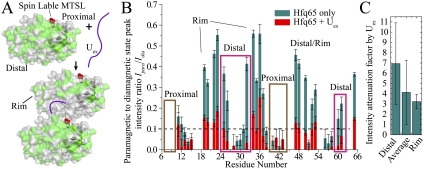Figure 5.
The proximal and distal sides from different Hfq65 hexamers cooperate in Uex binding. (A) Spin label MTSL was site-specifically conjugated to the proximal side residue Cys6 (red spheres) of Hfq65 S6C R16A/R17A. Hfq is presented in the molecular surface. Residues retaining >10% of intensity in the paramagnetic state are labeled green. Residues not assigned or with <10% intensity in the paramagnetic state are labeled gray. MTSL purged most resonance signals on the proximal side. When Uex was added to half of the molar concentration (50 μM) of the Hfq hexamer (0.1 mM), resonances on the distal side of Hfq were also significantly attenuated. Resonance peaks of a few residues on the rim of Hfq retained >10% intensity. This demonstrates that upon Uex binding, the distal side and proximal side from different hexamers approximate to bind the Uex molecule. (B) Histogram of the resonance intensity ratio of the paramagnetic state to the diamagnetic state of apo Hfq (blue) and Hfq bound to Uex (red) samples. The bound state ratios are plotted on top of (overlapping) the apo state columns. Errors are estimated by the signal-to-noise ratio of the NMR spectra. (C) Intensity attenuation factors induced by Uex binding (calculated as the ratio of the intensity ratios shown in B between Hfq-only and Hfq + Uex samples) averaged for the distal side, outer rim, and all residues. Resonances with <10% residue signal intensity in the paramagnetic state in the Hfq-only sample were not used in this calculation to avoid large error.

